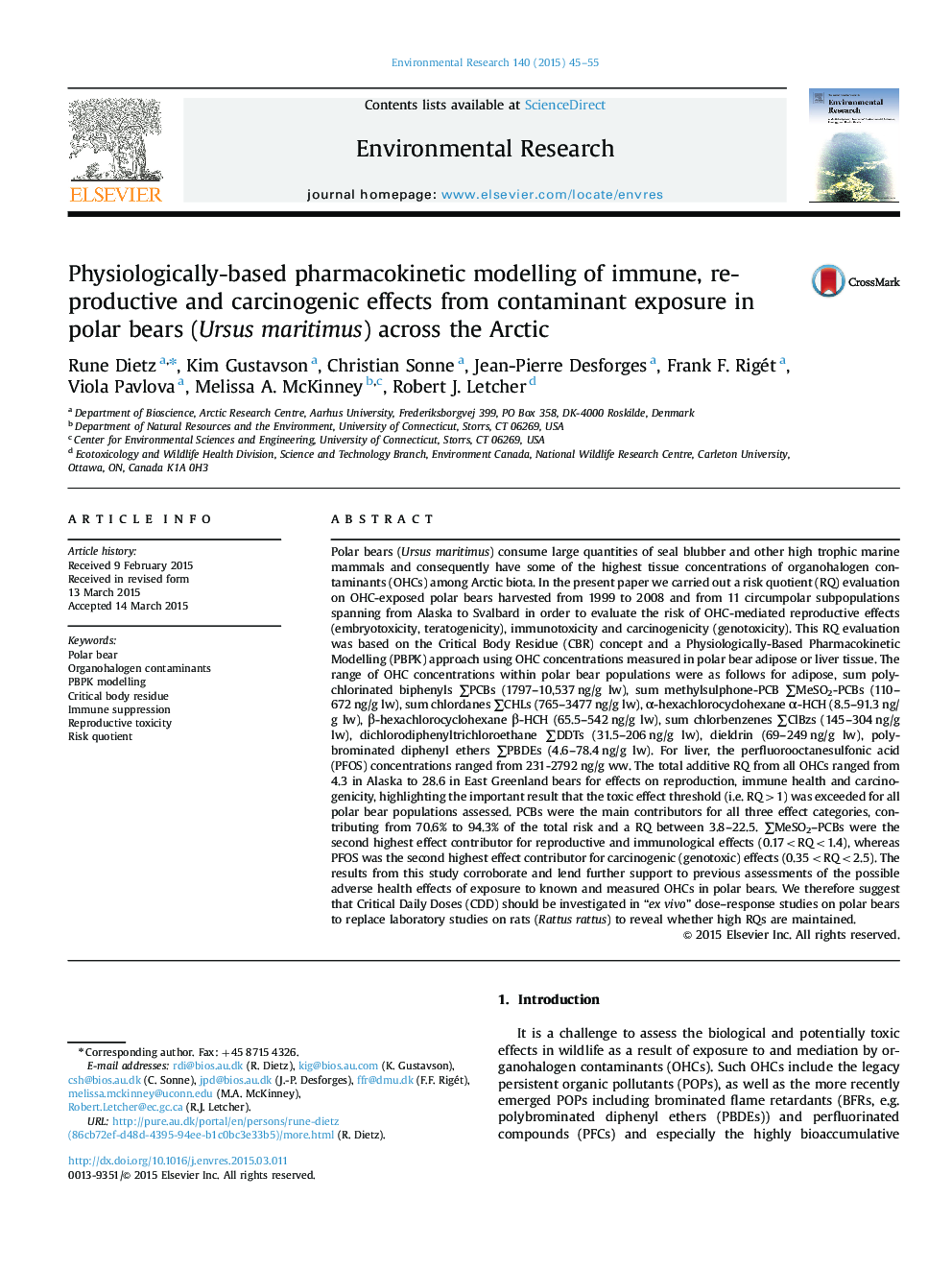| کد مقاله | کد نشریه | سال انتشار | مقاله انگلیسی | نسخه تمام متن |
|---|---|---|---|---|
| 6352049 | 1622561 | 2015 | 11 صفحه PDF | دانلود رایگان |
عنوان انگلیسی مقاله ISI
Physiologically-based pharmacokinetic modelling of immune, reproductive and carcinogenic effects from contaminant exposure in polar bears (Ursus maritimus) across the Arctic
دانلود مقاله + سفارش ترجمه
دانلود مقاله ISI انگلیسی
رایگان برای ایرانیان
کلمات کلیدی
موضوعات مرتبط
علوم زیستی و بیوفناوری
علوم محیط زیست
بهداشت، سم شناسی و جهش زایی
پیش نمایش صفحه اول مقاله

چکیده انگلیسی
Polar bears (Ursus maritimus) consume large quantities of seal blubber and other high trophic marine mammals and consequently have some of the highest tissue concentrations of organohalogen contaminants (OHCs) among Arctic biota. In the present paper we carried out a risk quotient (RQ) evaluation on OHC-exposed polar bears harvested from 1999 to 2008 and from 11 circumpolar subpopulations spanning from Alaska to Svalbard in order to evaluate the risk of OHC-mediated reproductive effects (embryotoxicity, teratogenicity), immunotoxicity and carcinogenicity (genotoxicity). This RQ evaluation was based on the Critical Body Residue (CBR) concept and a Physiologically-Based Pharmacokinetic Modelling (PBPK) approach using OHC concentrations measured in polar bear adipose or liver tissue. The range of OHC concentrations within polar bear populations were as follows for adipose, sum polychlorinated biphenyls âPCBs (1797-10,537 ng/g lw), sum methylsulphone-PCB âMeSO2-PCBs (110-672 ng/g lw), sum chlordanes âCHLs (765-3477 ng/g lw), α-hexachlorocyclohexane α-HCH (8.5-91.3 ng/g lw), β-hexachlorocyclohexane β-HCH (65.5-542 ng/g lw), sum chlorbenzenes âClBzs (145-304 ng/g lw), dichlorodiphenyltrichloroethane âDDTs (31.5-206 ng/g lw), dieldrin (69-249 ng/g lw), polybrominated diphenyl ethers âPBDEs (4.6-78.4 ng/g lw). For liver, the perfluorooctanesulfonic acid (PFOS) concentrations ranged from 231-2792 ng/g ww. The total additive RQ from all OHCs ranged from 4.3 in Alaska to 28.6 in East Greenland bears for effects on reproduction, immune health and carcinogenicity, highlighting the important result that the toxic effect threshold (i.e. RQ>1) was exceeded for all polar bear populations assessed. PCBs were the main contributors for all three effect categories, contributing from 70.6% to 94.3% of the total risk and a RQ between 3.8-22.5. âMeSO2-PCBs were the second highest effect contributor for reproductive and immunological effects (0.17
ناشر
Database: Elsevier - ScienceDirect (ساینس دایرکت)
Journal: Environmental Research - Volume 140, July 2015, Pages 45-55
Journal: Environmental Research - Volume 140, July 2015, Pages 45-55
نویسندگان
Rune Dietz, Kim Gustavson, Christian Sonne, Jean-Pierre Desforges, Frank F. Rigét, Viola Pavlova, Melissa A. McKinney, Robert J. Letcher,